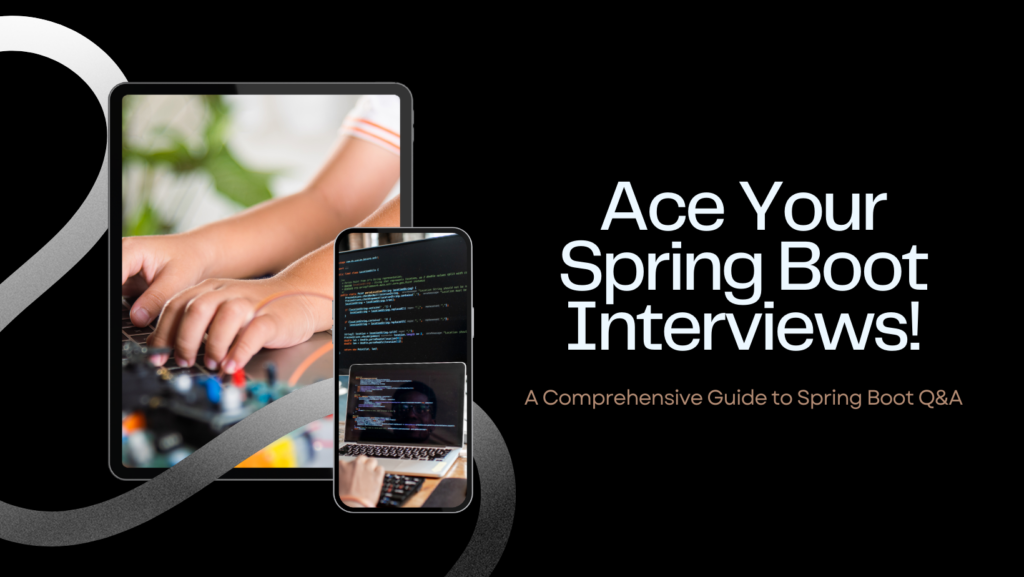Mastering Spring Boot: A Comprehensive Q&A Guide for Interviews

Spring Boot has emerged as a hot topic in Java application development interviews due to its rapid development, low configuration requirements, built-in server, and monitoring features. It enables the creation of robust and easily maintainable standalone Java applications from scratch.
This article will guide you through Spring Boot interview questions, covering topics from basic to advanced levels.
What is Spring Boot?
Spring Boot, a Java-based spring framework, focuses on Rapid Application Development, especially for building standalone microservices. It provides additional support for auto-configuration and embedded application servers like Tomcat and Jetty.
Features Setting Spring Boot Apart:
- Minimal Configuration: It facilitates creating standalone Spring applications with minimal configuration.
- Embedded Servers: Utilizes embedded servers like Tomcat or Jetty, simplifying the process of coding and running applications.
- Production-Ready Features: Offers production-ready features including metrics, health checks, and externalized configuration.
- No XML Configuration: Eliminates the need for XML configuration, relying instead on annotations.
- .
Top 15 Spring Boot Interview Questions:
Spring Boot Interview Questions: From Basic to Advanced Levels
1. What is Spring Boot?
- Answer: Spring Boot is a Java-based spring framework used for Rapid Application Development, particularly for standalone microservices. It features auto-configuration and supports embedded application servers like Tomcat and Jetty.
2. What distinguishes Spring Boot from traditional Spring?
- Answer: Spring Boot offers advantages such as Starter POM, Auto Configuration, Embedded Server, and eliminates XML configuration, which traditional Spring does not provide.
3. What are the standout features of Spring Boot?
- Answer: Noteworthy features include minimal configuration, utilization of embedded servers (Tomcat, Jetty), production-ready attributes like metrics and health checks, and no reliance on XML configuration.
4. Could you name commonly used Spring Boot starter dependencies?
- Answer: Data JPA, Test, Security, Web, Mail, and Thymeleaf starters are among the commonly used dependencies in Spring Boot.
5. How does Spring Boot function?
- Answer: Spring Boot auto-configures applications based on dependencies added, utilizing annotations for configuration.
6. What is Spring Initializer and what purpose does it serve?
- Answer: Spring Initializer is a web app facilitating the creation of initial Spring Boot project structures and providing maven or gradle files for building code.
7. Explain Spring Boot CLI and its advantages.
- Answer: Spring Boot CLI, a command-line interface, allows Groovy-based application creation, reducing verbosity in code, and providing automatic template loading (e.g., JDBC template).
8. Name some common Spring Boot CLI commands.
- Answer: Common commands include -run, -test, -jar, -war, -install, -uninstall, –init, -shell, and -help.
9. Can Spring Boot be used for non-web applications?
- Answer: Yes, by removing web dependencies and altering Spring Boot’s application context setup, it’s possible to create non-web applications.
10. What is the default port for Tomcat in Spring Boot? Can it be changed?
- Answer: The default port is 8080, modifiable using the
server.portproperty inapplication.properties.
11. Is it possible to replace the embedded Tomcat server in Spring Boot?
- Answer: Yes, it can be replaced by adding Starter dependencies in the
pom.xmlfile, like usingspring-boot-starter-jettyfor a Jetty server.
12. Can the default web server in a Spring Boot application be disabled?
- Answer: Yes, by configuring
spring.main.web-application-type=noneinapplication.properties.
13. How can one retrieve the list of all beans in a Spring Boot application?
- Answer: Utilize Spring Boot Actuator’s “/Beans” endpoint to fetch the list of Spring beans.
14. How does one access environment properties in a Spring Boot application?
- Answer: Access environment properties using Spring Boot Actuator’s “/env” endpoint, which displays all running application’s environment properties.
15. What are the methods to enable debugging logs in a Spring Boot application?
- Answer: Debugging logs can be enabled by starting the application with the
--debugswitch, settinglogging.level.root=debuginapplication.properties, or configuring the root logger’s level to debug in the logging configuration file.
This comprehensive guide aims to prepare you for Spring Boot interviews, covering crucial concepts and common interview questions ranging from basics to intricate details.

Leave a Reply